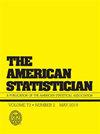当前拟合线性混合模型的软件程序概述。
IF 1.8
4区 数学
Q1 STATISTICS & PROBABILITY
引用次数: 45
摘要
目前,有许多可用的软件程序使统计学家能够将线性混合模型(lmm)拟合到聚类或纵向数据集中的连续因变量中。lmm是分析这些类型数据集中变量之间关系的灵活工具,因为可以根据所研究的主题使用各种协方差结构。lmm中明确的随机效应允许分析人员对更大的假设人群中集群或受试者之间的可变性进行推断,并检查解释这种可变性的部分集群或受试者水平变量。这些模型还可以用于分析纵向或聚类数据集,这些数据集具有随机缺失(MAR)的数据,并且可以在纵向数据集中容纳时变协变量。虽然目前可用的软件程序有许多共同的特征,但拟合lmm的更具体的分析方面(例如,交叉随机效应,方差成分的适当假设检验,诊断,纳入抽样权重)可能只在选定的软件程序中可用。在本文中,我们的目标是对适合lmm的软件过程的当前能力进行全面和最新的比较,并为统计学家提供选择适合其分析目标的软件过程的指南。本文章由计算机程序翻译,如有差异,请以英文原文为准。
An Overview of Current Software Procedures for Fitting Linear Mixed Models.
At present, there are many software procedures available that enable statisticians to fit linear mixed models (LMMs) to continuous dependent variables in clustered or longitudinal datasets. LMMs are flexible tools for analyzing relationships among variables in these types of datasets, in that a variety of covariance structures can be used depending on the subject matter under study. The explicit random effects in LMMs allow analysts to make inferences about the variability between clusters or subjects in larger hypothetical populations, and examine cluster- or subject-level variables that explain portions of this variability. These models can also be used to analyze longitudinal or clustered datasets with data that are missing at random (MAR), and can accommodate time-varying covariates in longitudinal datasets. Although the software procedures currently available have many features in common, more specific analytic aspects of fitting LMMs (e.g., crossed random effects, appropriate hypothesis testing for variance components, diagnostics, incorporating sampling weights) may only be available in selected software procedures. With this article, we aim to perform a comprehensive and up-to-date comparison of the current capabilities of software procedures for fitting LMMs, and provide statisticians with a guide for selecting a software procedure appropriate for their analytic goals.
求助全文
通过发布文献求助,成功后即可免费获取论文全文。
去求助
来源期刊

American Statistician
数学-统计学与概率论
CiteScore
3.50
自引率
5.60%
发文量
64
审稿时长
>12 weeks
期刊介绍:
Are you looking for general-interest articles about current national and international statistical problems and programs; interesting and fun articles of a general nature about statistics and its applications; or the teaching of statistics? Then you are looking for The American Statistician (TAS), published quarterly by the American Statistical Association. TAS contains timely articles organized into the following sections: Statistical Practice, General, Teacher''s Corner, History Corner, Interdisciplinary, Statistical Computing and Graphics, Reviews of Books and Teaching Materials, and Letters to the Editor.
 求助内容:
求助内容: 应助结果提醒方式:
应助结果提醒方式:


